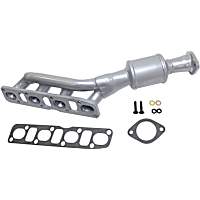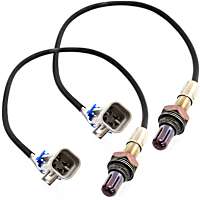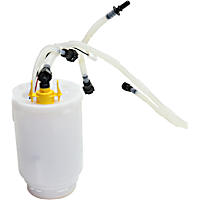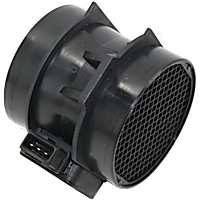There is an ideal ratio for the mixture of air and fuel that your car’s engine burns in its combustion chambers. An excessive amount of oxygen in the mixture means your engine might be running lean, which could trigger the P2096 code on an OBD-II scanner. Find out everything you need to know about this code by reading on.
What Does the P2096 Code Mean?
Code P2096 stands for “Post Catalyst Fuel Trim System Too Lean (Bank 1)”. The code indicates that your car’s primary computer, which is often referred to as the powertrain control module or PCM, perceives a lean fuel-to-air mixture downstream of the catalytic converter.

In V6 and V8 engines, Bank 1 refers to the oxygen sensor on the side with the number 1 cylinder. The term doesn’t apply to engines with 4 cylinders or straight 6 cylinders.

To make sense of code P2096, it helps to have some background information. The PCM keeps track of the fuel mixture ratio through oxygen sensors in the exhaust system that measure the amount of oxygen burned by the engine. There is an oxygen sensor positioned before and after the catalytic converter.
One oxygen sensor, which is referred to as the upstream sensor, sits between the engine and converter. There’s also a downstream oxygen sensor that evaluates the O2 levels coming out of the converter.
Higher levels of oxygen in the exhaust tell the computer that the engine is burning a lean fuel-air mix. Conversely, lower oxygen content suggests a rich mix. The readings from the upstream sensor guide the computer in adjusting the engine’s fuel intake, and it usually aims for a 14.7:1 ratio between fuel and air.
Meanwhile, the PCM primarily uses the data from the downstream O2 sensor to determine the efficiency of the catalytic converter.
The front oxygen sensor should detect a higher oxygen count than the rear sensor since the catalytic converter expends some of the unburned oxygen. If both sensors show similar data indicating a lean condition, code P2096 may be set.
Many owners have reported p2096 for the following makes: Subaru, BMW, Nissan, Hyundai, and Jeep.

What are the Possible Causes of the P2096 Code?
The lean fuel-air mix that triggered the code P2096 can originate from various issues within the vehicle. Here are some of the most common:
- Fuel delivery issues (e.g., clogging in the filter and injectors, a bad fuel pump, and a faulty fuel pressure regulator)
- Engine vacuum leak
- Exhaust leak that’s creating a false lean condition (leaks can be caused by corroded exhaust systems, cracks in exhaust manifold, and damaged or displaced seals)
- Faulty catalytic converter
- Bad oxygen sensor
- Circuit issues (e.g., damaged wiring or loose connections)
- Bad or failing Mass Airflow sensor
- Problem with the PCM (rare)
What are the Common Symptoms of the P2096 Code?
As with most OBD-II codes, an illuminated check engine light or malfunction indicator lamp is one of the most common symptoms you will experience when the car’s computer detects code P2096.
Other symptoms can turn up depending on the specific part or system responsible for the issue in the fuel trim. Here are some other common symptoms:
- Rough idle
- Bad fuel economy
- Vehicle accelerates poorly
- Engine misfires
How to Diagnose the P2096 Code
P2096 can be a serious issue. You need to check all potential causes to pinpoint the exact problem. If you don’t have enough DIY auto repair experience, it may be best to take your vehicle to a mechanic. However, if you still want to take a stab at the diagnosis process, the videos below can help you do it correctly.
How to Fix the P2096 Code
There’s really no one-size-fits-all solution to OBD-II trouble codes. With the variety of possible causes, there’s also bound to be many different possible solutions for repair. Not to mention, different vehicles have different sets of instructions on how to diagnose and fix certain problems with the affected parts or systems.
These are the reasons why proper diagnosis is the key to effective repair. Good thing there are a lot of resources out there to help you diagnose and fix OBD-II trouble codes. Repair manuals and owner’s manuals are very helpful for this purpose.
Consulting your local mechanic is also an option. However, for DIYers, it’s great to have a handy repair resource like ALLDATA. With a single-vehicle subscription, you’re sure to get detailed and specific factory repair information at your fingertips.
Where to Get a High-Quality Catalytic Converter for Your Ride
One of the possible causes of a P2096 code is a bad cat-con. Fortunately, you don’t have to leave your home just to look for a compatible catalytic converter replacement for your vehicle.
Here at CarParts.com, shopping for a catalytic converter is fast and hassle-free. You can access our website using your mobile phone and browse through our selection of aftermarket catalytic converters. We have built-in search filters, so you can customize your search according to your preferred brand or price range.
Our cat-cons all come with a low-price guarantee, so you won’t have to go over your budget just to get your vehicle back on the road again. All our replacement parts come from top aftermarket manufacturers to ensure utmost quality and durability.
Got questions? Don’t hesitate to call our toll-free hotlines. Our team is ready to assist you in all your queries.
Don’t put off replacing a bad cat-con. Shop now and enjoy the best deals!
Products Mentioned in this Guide
Any information provided on this Website is for informational purposes only and is not intended to replace consultation with a professional mechanic. The accuracy and timeliness of the information may change from the time of publication.


 Catalytic Converter
Catalytic Converter
 Oxygen Sensor
Oxygen Sensor
 Fuel Pump
Fuel Pump
 Mass Air Flow Sensor
Mass Air Flow Sensor
















